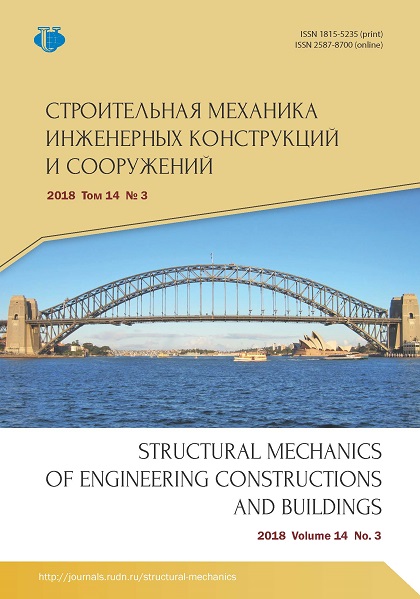EXPERIMENTAL INVESTIGATIONS OF REINFORCED CONCRETE STRUCTURES OF HYDRAULIC STRUCTURES WITH BLOCK SEAMS, ENHANCED BY THE EXTERNAL REINFORCEMENT SYSTEM
- Authors: Rubin OD1, Lisichkin SE2, Frolov KE3
-
Affiliations:
- Scientific Research Institute of Energy Structures (Joint-Stock Company)
- Engineering Center of Structures, Constructions and Technologies in Power Engineering (Limited Liability Company)
- PJSC RusHydro
- Issue: Vol 14, No 3 (2018)
- Pages: 198-204
- Section: Experimental researches
- URL: https://journals.rudn.ru/structural-mechanics/article/view/18930
- DOI: https://doi.org/10.22363/1815-5235-2018-14-3-198-204
Cite item
Full Text
Abstract
A method of strengthening reinforced concrete structures by external reinforcement systems based on carbon fiber is widely used. Significant experience is accumulated in industrial and civil construction; there is also a certain experience of strengthening reinforced concrete structures of hydraulic structures. It was necessary to conduct experimental studies to justify technical solutions for strengthening the reinforced concrete structures of hydraulic structures. A characteristic feature of reinforced concrete structures of hydraulic structures is the mandatory availability of inter-block construction joints, which are caused by the need to build massive hydraulic structures with tiers and blocks with interruptions in concreting. Previously studies of reinforced concrete structures strengthened by composite materials were conducted without taking into account the block structure. The results of experimental studies of reinforced concrete beam structures of hydraulic structures reinforced with carbon strips having horizontal and vertical inter-block building seams are presented in the article. Experimental studies of a series of reinforced concrete beam-type models made of concrete of class B15 with longitudinal reinforcement from two bars. Their diameter is 10 mm and class is A500C (percentage of reinforcement 0.39%). The used concrete class is B25 with longitudinal reinforcement of three bars of diameter 12 mm and class A500C (percentage of reinforcement 0.84%). Their inter-block construction joints is before their strengthening and after reinforcement by longitudinal and transverse carbon composite tapes. In this case, a special type of cracking was recorded, in which cracks propagate along vertical and horizontal inter-block building seams. Due to the strengthening of reinforced concrete structures with carbon composite strips, the strength of the structures has increased, on average, by 1.78 times.
About the authors
O D Rubin
Scientific Research Institute of Energy Structures (Joint-Stock Company)
Author for correspondence.
Email: info@niies.ru
Doctor of Technical Sciences, General Director, Scientific Research Institute of Energy Structures (NIIES) (Joint-Stock Company). Scientific interests: safety of hydraulic structures, theory of massive reinforced concrete hydraulic structures, composite materials.
7A Stroitel'nyi proezd, Moscow, 125362, RussiaS E Lisichkin
Engineering Center of Structures, Constructions and Technologies in Power Engineering (Limited Liability Company)
Email: cskte@mail.ru
Doctor of Technical Sciences, Deputy General Director, Head of Division, LLC “Engineering Center of Structures, Constructions and Technologies in Power Engineering” (ITCSKTE) (Limited Liability Company). Scientific interests: safety of hydrau- lic structures, theory of massive reinforced concrete hydraulic structures, composite materials
35 Svobody St., Moscow, 125362, RussiaK E Frolov
PJSC RusHydro
Email: frolovke@gidroogk.ru
Engineer, Deputy General Director for Scientific and Design Activities, PJSC RusHydro. Scientific interests: safety of hydraulic structures, theory of massive reinforced concrete hydraulic structures, composite materials
7 Malaya Dmitrovka St., Moscow, 127006, RussiaReferences
- Rubin O.D., Lisichkin S.E., Balagurov V.B., Aleksandrov A.V. (2016). Novaya tekhnologiya remonta GTS posredstvom armirovaniya kompozitnymi materialami [New technology of repairing hydraulic structures by means of reinforcement with composite materials]. Izvestiya VNIIG, Vol. 280, 3–10. (In Russ.)
- Rubin O.D., Lisichkin S.E., Frolov K.E. (2016). Rezul'taty ehksperimental'nyh issledovanij zhelezobetonnyh konstrukcij gidrotekhnicheskih sooruzhenij, usilennyh uglerodnymi lentami, pri dejstvii izgibayushchego momenta [The results of experimental studies of reinforced concrete structures of hydraulic buildings reinforced with carbon ribbons and subject to a bending moment]. Structural Mechanics of Engineering Constructions and Buildings, No 6, 58–63. (In Russ.)
- SP 41.13330.2012. Betonnye i zhelezobetonnye konstrukcii gidrotekhnicheskih sooruzhenij. Aktualizirovannaya redakciya SNiP 2.06.08-87 [Concrete and reinforced concrete structures of hydraulic buidings. Actualized edition of SNiP 2.06.08-87]. Moscow, 2012, 67. (In Russ.)
- P 46-89. Posobie po proektirovaniyu betonnyh i zhelezobetonnyh konstrukcij gidrotekhnicheskih sooruzhenij (bez predvaritel'nogo napryazheniya) k SNiP 2.06.08-87 [Manual for the design of concrete and reinforced concrete structures of hydraulic buildings (without prestressing) to SNiP 2.06.08-87]. Ministerstvo ehnergetiki i ehlektrifikacii SSSR. Leningrad: VNIIG im. B.E. Vedeneeva Publ., 1991. (In Russ.)
- Serdyuk A.I., Chernyavskij V.L. (2013). Opyt usileniya stroitel'nyh konstrukcij kompozicionnymi materialami pri rekonstrukcii Baksanskoj GEHS [Experience in strengthening building structures with composite materials during the reconstruction of the Baksanskaya Hydroelectric Power Station]. Gidrotekhnika, 3(32), 115–117. (In Russ.)
- Zhou Y. et al. (2013). Reinforced concrete beams strengthened with carbon fiber reinforced polymer by friction hybrid bond technique: Experimental investigation. Materials and Design, 50, 130–139.
- Akbarzadeh H., Maghsoudi A.A. (2010). Experimental and analytical investigation of reinforced high strength concrete continuous beams strengthened with fiber reinforced polymer. Mater Des, 31, 1130–1147.
- Wu Y.F., Lu J. (2013). Preventing debonding at the steel to concrete interface through strain localization. Compositer Part B, 45, 1061–1070
















